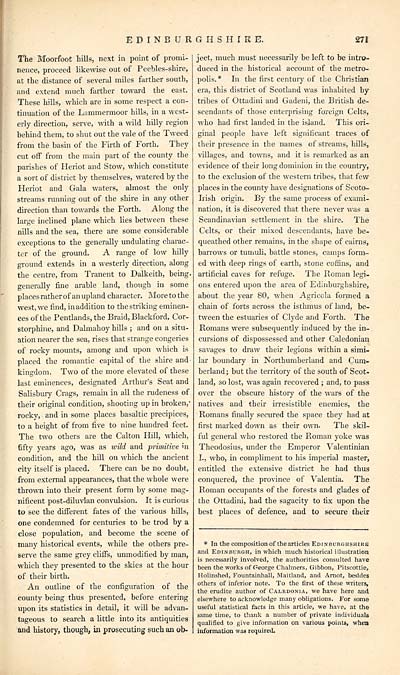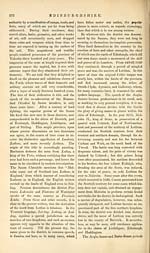Gazetteer of Scotland > Volume 1
(303) Page 271
Download files
Complete book:
Individual page:
Thumbnail gallery: Grid view | List view

EDINBURGHSHIRE.
271
The Moorfoot hills, next in point of promi-
nence, proceed likewise out of Peebles-shire,
at the distance of several miles farther south,
and extend much farther toward the east.
These hills, which are in some respect a con-
tinuation of the Lammermoor hills, in a west-
erly direction, serve, with a wild hilly region
behind them, to shut out the vale of the Tweed
from the basin of the Firth of Forth. They
cut off from the main part of the county the
parishes of Heriot and Stow, which constitute
a sort of district by themselves, watered by the
Heriot and Gala waters, almost the only
streams running out of the shire in any other
direction than towards the Forth. Along the
large inclined plane which lies between these
nills and the sea, there are some considerable
exceptions to the generally undulating charac-
ter of the ground. A range of low hilly
ground extends in a westerly direction, along
the centre, from Tranent to Dalkeith, being,
generally fine arable land, though in some
places rather of an upland character. More to the
west, we find, in addition to the striking eminen-
ces of the Pentlands, the Braid, Blackford, Cor-
storphine, and Dalmahoy hills ; and on a situ-
ation nearer the sea, rises that strange congeries
of rocky mounts, among and upon which is
placed the romantic capital of the shire and
kingdom. Two of the more elevated of these
last eminences, designated Arthur's Seat and
Salisbury Crags, remain in all the rudeness of
their original condition, shooting up in broken, -
rocky, and in some places basaltic precipices,
to a height of from five to nine hundred feet.
The two others are the Calton Hill, which,
fifty years ago, was as wild and primitive in
condition, and the hill on which the ancient
city itself is placed. There can be no doubt,
from external appearances, that the whole were
thrown into their present form by some mag-
nificent post-diluvian convulsion. It is curious
to see the different fates of the various hills,
one condemned for centuries to be trod by a
close population, and become the scene of
many historical events, while the others pre-
serve the same grey cliffs, unmodified by man,
which they presented to the skies at the hour
of their birth.
An outline of the configuration of the
county being thus presented, before entering
upon its statistics in detail, it will be advan-
tageous to search a little into its antiquities
and history, though, in prosecuting such an ob-
ject, much must necessarily be left to be intro-
duced in the historical account of the metro-
polis.* In the first century of the Christian
era, this district of Scotland was inhabited by
tribes of Ottadini and Gadeni, the British de-
scendants of those enterprising foreign Celts,
who had first landed in the island. This ori-
ginal people have left significant traces of
their presence in the names of streams, hills,
villages, and towns, and it is remarked as an
evidence of their long dominion in the country,
to the exclusion of the western tribes, that few
places in the county have designations of Scoto-
Irish origin. By the same process of exami-
nation, it is discovered that there never was a
Scandinavian settlement in the shire. The
Celts, or their mixed descendants, have be-
queathed other remains, in the shape of cairns,
barrows or tumuli, battle stones, camps form-
ed with deep rings of earth, stone coffins, and
artificial caves for refuge. The Roman legi-
ons entered upon the area of Edinburghshire,
about the year 80, when Agricola formed a
chain of forts across the isthmus of land, be-
tween the estuaries of Clyde and Forth. The
Romans were subsequently induced by the in-
cursions of dispossessed and other Caledonian
savages to draw their legions within a simi-
lar boundary in Northumberland and Cum-
berland ; but the territory of the south of Scot-
land, so lost, was again recovered ; and, to pass
over the obscure history of the wars of the
natives and their irresistible enemies, the
Romans finally secured the space they had at
first marked down as their own. The skil-
ful general who restored the Roman yoke was
Theodosius, under the Emperor Valentinian
I., who, in compliment to his imperial master,
entitled the extensive district he had thus
conquered, the province of Valentia. The
Roman occupants of the forests and glades of
the Ottadini, had the sagacity to fix upon the
best places of defence, and to secure their
* In the composition of the articles EDiNnuRGHSHiRB
and Edinburgh, in which much historical illustration
is necessarily involved, the authorities consulted have
been the works of George Chalmers, Gibbon, Pitscottie,
Holinshed, Fountainhall, Maitland, and Arnot, besides
others of inferior note. To the first of these writers,
the erudite author of Caledonia, we have here and
elsewhere to acknowledge many obligations. For some
useful statistical facts in this article, we have, at the
same time, to thank a number of private individuals
qualified to give information on various points, whea
information was required.
271
The Moorfoot hills, next in point of promi-
nence, proceed likewise out of Peebles-shire,
at the distance of several miles farther south,
and extend much farther toward the east.
These hills, which are in some respect a con-
tinuation of the Lammermoor hills, in a west-
erly direction, serve, with a wild hilly region
behind them, to shut out the vale of the Tweed
from the basin of the Firth of Forth. They
cut off from the main part of the county the
parishes of Heriot and Stow, which constitute
a sort of district by themselves, watered by the
Heriot and Gala waters, almost the only
streams running out of the shire in any other
direction than towards the Forth. Along the
large inclined plane which lies between these
nills and the sea, there are some considerable
exceptions to the generally undulating charac-
ter of the ground. A range of low hilly
ground extends in a westerly direction, along
the centre, from Tranent to Dalkeith, being,
generally fine arable land, though in some
places rather of an upland character. More to the
west, we find, in addition to the striking eminen-
ces of the Pentlands, the Braid, Blackford, Cor-
storphine, and Dalmahoy hills ; and on a situ-
ation nearer the sea, rises that strange congeries
of rocky mounts, among and upon which is
placed the romantic capital of the shire and
kingdom. Two of the more elevated of these
last eminences, designated Arthur's Seat and
Salisbury Crags, remain in all the rudeness of
their original condition, shooting up in broken, -
rocky, and in some places basaltic precipices,
to a height of from five to nine hundred feet.
The two others are the Calton Hill, which,
fifty years ago, was as wild and primitive in
condition, and the hill on which the ancient
city itself is placed. There can be no doubt,
from external appearances, that the whole were
thrown into their present form by some mag-
nificent post-diluvian convulsion. It is curious
to see the different fates of the various hills,
one condemned for centuries to be trod by a
close population, and become the scene of
many historical events, while the others pre-
serve the same grey cliffs, unmodified by man,
which they presented to the skies at the hour
of their birth.
An outline of the configuration of the
county being thus presented, before entering
upon its statistics in detail, it will be advan-
tageous to search a little into its antiquities
and history, though, in prosecuting such an ob-
ject, much must necessarily be left to be intro-
duced in the historical account of the metro-
polis.* In the first century of the Christian
era, this district of Scotland was inhabited by
tribes of Ottadini and Gadeni, the British de-
scendants of those enterprising foreign Celts,
who had first landed in the island. This ori-
ginal people have left significant traces of
their presence in the names of streams, hills,
villages, and towns, and it is remarked as an
evidence of their long dominion in the country,
to the exclusion of the western tribes, that few
places in the county have designations of Scoto-
Irish origin. By the same process of exami-
nation, it is discovered that there never was a
Scandinavian settlement in the shire. The
Celts, or their mixed descendants, have be-
queathed other remains, in the shape of cairns,
barrows or tumuli, battle stones, camps form-
ed with deep rings of earth, stone coffins, and
artificial caves for refuge. The Roman legi-
ons entered upon the area of Edinburghshire,
about the year 80, when Agricola formed a
chain of forts across the isthmus of land, be-
tween the estuaries of Clyde and Forth. The
Romans were subsequently induced by the in-
cursions of dispossessed and other Caledonian
savages to draw their legions within a simi-
lar boundary in Northumberland and Cum-
berland ; but the territory of the south of Scot-
land, so lost, was again recovered ; and, to pass
over the obscure history of the wars of the
natives and their irresistible enemies, the
Romans finally secured the space they had at
first marked down as their own. The skil-
ful general who restored the Roman yoke was
Theodosius, under the Emperor Valentinian
I., who, in compliment to his imperial master,
entitled the extensive district he had thus
conquered, the province of Valentia. The
Roman occupants of the forests and glades of
the Ottadini, had the sagacity to fix upon the
best places of defence, and to secure their
* In the composition of the articles EDiNnuRGHSHiRB
and Edinburgh, in which much historical illustration
is necessarily involved, the authorities consulted have
been the works of George Chalmers, Gibbon, Pitscottie,
Holinshed, Fountainhall, Maitland, and Arnot, besides
others of inferior note. To the first of these writers,
the erudite author of Caledonia, we have here and
elsewhere to acknowledge many obligations. For some
useful statistical facts in this article, we have, at the
same time, to thank a number of private individuals
qualified to give information on various points, whea
information was required.
Set display mode to: Large image | Transcription
Images and transcriptions on this page, including medium image downloads, may be used under the Creative Commons Attribution 4.0 International Licence unless otherwise stated. ![]()
| Gazetteers of Scotland, 1803-1901 > Gazetteer of Scotland > Volume 1 > (303) Page 271 |
|---|
| Permanent URL | https://digital.nls.uk/97427998 |
|---|
| Description | Volume I: Abbey to Glenartney. |
|---|---|
| Attribution and copyright: |
|
| Description | By Robert Chambers and William Chambers. Glasgow: Blackie & Son, 1838. 2 volumes. |
|---|---|
| Shelfmark | NF.1461.g.7 |
| Additional NLS resources: | |

